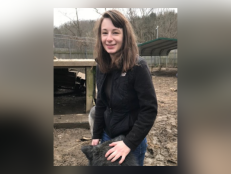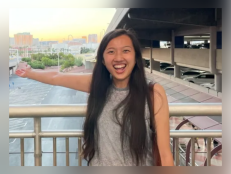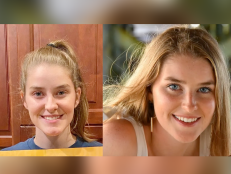Who Are The 2 Amateur Genealogists Who Are Solving Cold Cases With DNA?
Markers found in Lyle Stevik’s DNA matched to probable distant cousins in Northern New Mexico and the greater Four-Corners area.
![Colleen Fitzpatrick [courtesy Colleen Fitzpatrick]; Margaret Press [courtesy Margaret Press]](http://investigationdiscovery.sndimg.com/content/dam/images/investigationdiscovery/crimefeed/legacy/2018/10/Colleen-Fitzpatrick-Margaret-Press-10042018.gif.rend.hgtvcom.616.347.suffix/1539120395379.gif)
Colleen Fitzpatrick [courtesy Colleen Fitzpatrick]; Margaret Press [courtesy Margaret Press]
The following is an excerpt from "Beyond the Jungle of Bad: The True Story of Two Women From California Who Are Solving All The Mysteries," a longform article by James Renner, author of True Crime Addict.
![cover art for True Crime Addict [Amazon]](http://investigationdiscovery.sndimg.com/content/dam/images/investigationdiscovery/crimefeed/legacy/2018/10/James-Renner-Book-10042018-199x300.jpg.rend.hgtvcom.581.872.suffix/1539120484818.jpeg)
cover art for True Crime Addict [Amazon]
Colleen Fitzpatrick and Margaret Press, two women whose intelligence, ambition, and desire to help solve mysteries have led to the use of forensic genealogy to solve open cases.
Case Study: Lyle Stevik
This mystery began on September 14, 2001, three days after the towers came down. A young man checked into the Quinault Inn, a motel in Amanda Park, Washington, under the name “Lyle Stevik.” He had no luggage. No I.D. Only the clothes on his back, some cash, and a toothbrush. Three days later, he was found hanging from a belt tied around a clothes rod in the closet of his room. His name was fictitious, a character from a Joyce Carol Oates’ novel, and the address he gave to the clerk led to a hotel in Idaho.
Armchair sleuths wondered if the man was part of the terror cell that had orchestrated the September 11 attacks – did he kill himself before the feds could catch him?
Police collected his DNA, sent it to the lab, and then entered his profile into the F.B.I.’s Combined DNA Index System – known as CODIS – the government’s private database of felon DNA. No match. But that only meant he’d never been to prison.
Colleen [Fitzpatrick] read about the case and reached out to the local coroner, Lane Youmans. It was the perfect mystery for the DNA Doe Project to solve. Youmans was game but there was a problem — the county didn’t have the money for testing. So Colleen and Margaret [Press] organized their first “DoeFundMe" campaign to raise funds for a new, autosomal DNA test. Redditors and members of their Facebook group opened their wallets. They raised the $1,500 needed for the testing within 12 hours.
Youmans sent Lyle’s DNA to the lab, where it was sequenced and then converted to electronic data and saved on a hard drive. Colleen then had a bioinformatics expert extract specific snips from this data that are also used by GEDMatch. The markers from Lyle’s profile were then compared to the markers from other people’s profiles on the website (the software does this – nobody can ever see or directly access someone else’s DNA profile). Markers found in Lyle’s DNA matched to probable distant cousins in Northern New Mexico and the greater Four-Corners area. But it was hard to narrow it down from there. The problem was endogamy.
![Artist reconstruction of Lyle Stevik [Wikipedia]](http://investigationdiscovery.sndimg.com/content/dam/images/investigationdiscovery/crimefeed/legacy/2018/10/Lyle-Stevik-10042018.gif.rend.hgtvcom.616.347.suffix/1539120495264.gif)
Photo: Artist reconstruction of Lyle Stevik by Carl Koppelman (TheDoeNetwork)
Endogamy occurs in isolated community groups – most notably Appalachia, where cousins intermarry and people are sometimes related to each other in five different ways. In the Lyle Stevik case, the results brought Colleen and Margaret to a region of the United States that originally settled by Spanish conquistadors who took Native Americans as wives. Their descendants had been isolated from the greater world and there had been a lot of intermarriage. The team felt they were close but it was going to be difficult to hone in on the man’s identity because of the intertwined branches of his family tree.
GEDmatch has lots of nifty tools. One of them is a program called “Are my parents related?” Colleen clicked on it, expecting to find that Lyle’s parents were related like everyone around them, but they were not. Colleen knew that this must mean one of Lyle’s parents were not from the same region. Another researcher in their group noticed a particular snip on Lyle’s Y-chromosome that matched to a man from south America – which suggested his father likely came from there, too. And that meant his mother must be the parent who was native to the Four Corners area.
The team spent hundreds of hours building out family trees for the matches. One lucky volunteer contacted a family member from this region to help them make better sense of the family tree. That family member mentioned that she had heard that a young man, distantly related to her, had gone missing some years ago. They had stumbled onto their answer sooner than expected.
“These cases are like trying to figure out a giant Sudoku puzzle,” says Margaret. “And this solution fit the puzzle.”
Case closed. Sure. But the state of Washington does not release the names of suicides. And the family of the deceased did not come forward, publicly.
“In many cultures there’s shame associated with suicide,” Margaret explains. “My brother committed suicide. It was never in the papers. The publicity would have added to the pain. I can think of no reason this family would want to make it public.”
That made some Redditors who had donated money very angry. “They’re saying, ‘We have a right to this knowledge. We’re entitled to know who he is,’” says Margaret.
It was an unexpected reaction but Colleen and Margaret were not discouraged. Lyle’s case and the others they were working on proved that the DNA Doe Project worked. “This was unprecedented,” says Colleen. But there was a growing concern that others in the genealogical community would view what they were doing as an invasion of privacy. Each time they solved a new case, it brought more attention. Eventually, GEDMatch would have to decide what was permissible. And what would happen to their efforts to identify their John and Jane Does if the database they relied on suddenly changed its terms of service? What if it simply shut down? “If GEDmatch rolled up the sidewalk, we were toast.”
Margaret sighs. “And then the Golden State Killer happened.”
Now that police know what a forensic genealogist can do, Colleen’s phone rings incessantly.
She still does most of her work sitting at a small table in the kitchen of the same townhouse she’s lived in for decades. “I’m getting calls and emails every day. I’m working on a dozen cases.”
Her house is not large — a couple of rooms and bedrooms upstairs. She sublets one of her rooms to a friend. For her dream job to survive, the DNA Doe Project will need funding.
Her siblings are not so worried, though. They remember the girl from Lakeview who found a way to get all the beads she ever needed. “She loves a challenge,” says her sister, Bebe. “Maybe it’s in her DNA.”
Colleen’s brother, Tim, is a part-time deputy back home and runs search-and-rescue boats when he’s not designing Christmas decorations for fancy businesses in four states. “I’m really proud of her,” he says. “It puts a smile on her face which she hasn’t had in a long time. I’m enjoying watching her. It’s tremendous.”
No matter what happens, Colleen and Margaret have each other’s back. “When you work these cases, you feel that incipient gloom and it can affect you,” says Margaret. “We rely on each other and our team and we focus on the excitement of being the ones to solve a case. And we are. We’re solving them doe by doe by doe. It’s a jungle of bad out there but we’re chopping through it.”
There’s a picture of the Dalai Lama hanging on Colleen’s wall. It’s signed. “I don’t know what the reason is I find myself here, now,” she muses, thinking on the events that stretch back to New Orleans and a simpler time. “Was it to bring closure to these cases? It could be. I might have fulfilled my purpose 10 years ago. How do I know? You just gotta do what you can.”
Click here to read the full text of "Beyond the Jungle of Bad: The True Story of Two Women From California Who Are Solving All The Mysteries."
James Renner is the author of True Crime Addict. Recently, he filmed a virtual reality docu-series about the Delphi Murders.

![Lauren Dumolo [via Cape Coral Police Department]](http://investigationdiscovery.sndimg.com/content/dam/images/investigationdiscovery/crimefeed/legacy/2021/03/cape-coral-pd-lauren-dumolo-030721.png.rend.hgtvcom.231.174.suffix/1615095615372.png)







